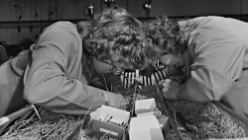In 1986, photographer Lee Friedlander was invited to Chippewa Falls, Wisconsin, by supercomputer maker Cray Research, which had hired the famous documentarian to shoot images for a book celebrating its 15th anniversary. Based on the 79 photographs on view in Lee Friedlander: The Cray Photographs, through June 16, 2013, at the Cantor Arts Center, Friedlander spent a fair amount of time wandering the banks of the Chippewa River on an overcast day, taking pictures of bare trees, a trio of fishermen in a canoe and the town’s namesake falls, which are more like a series of rapids than a cliff-like Niagara. He also poked around the town, shooting traffic signs in mostly empty streets, documenting a cluster of oil-storage tanks near a cemetery, and taking a few shots of train tracks and the desolation they pass through.
When Friedlander was outside, the silver hue of his black-and-whites seemed to leech the life out of his compositions, conspiring to make the bleak scenes he’d captured even bleaker. But when Friedlander stepped inside Cray Research, his black-and-whites suddenly imbued the mundane with meaningfulness, if not meaning.

Lee Friedlander, Cray at Chippewa Falls, Wisconsin, 1986
That last problem could have been rectified by the Cantor, whose curators offer viewers scant information about the subject of the photographs before us. While I admired the presentation of the photos themselves, lined up at the same height in a single row around the gallery’s perimeter, like so many ones and zeros in a line of code, it would have been nice to get some background about Cray to give the images context.
For example, in one photo, a group of men, including a guy who resembles George Lucas and another who looks like a younger Milton from Office Space, are somberly considering some aspect of some part of a Cray X-MP. Unfortunately, the only way I know it’s a Cray X-MP is that I looked it up on the interwebs (the Computer History Museum also has a number of useful pages on Cray). I get that these photos would be important to an art museum because they were shot by the great Lee Friedlander (I’m a fan of his work, too), but would it have been a crime to pick up the phone and call a couple former Cray engineers to get some details about what we’re actually looking at?




